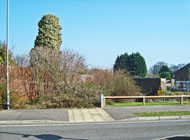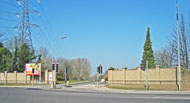Sandhurst Hospital
Royal Gunpowder Works, Epping Forest, Essex
Medical dates:
Medical character:
Acute
The Sandhurst Hospital opened in
1894. It was located near the refinery gate of the Royal Gunpowder
Works, facing the canal, as most transport within the factory
was by boat. Three years earlier an explosion had occurred at the
factory and it had been decided to build a hospital on site, as the
nearest hospital was 10 miles away in Tottenham. The newly built
Hospital enabled injured workmen to receive initial emergency treatment
before being transferred elsewhere.
The 2-storey building was built of brick and had a red-tiled roof. It had 8 beds - 5 in one ward and 3 in another - on the ground floor. As well as the wards, the ground floor contained various offices, including the Matron's, a dispensary, a kitchen, a larder and scullery, a bathroom and a servant's bedroom. On the upper floor were Matron's bedroom and sitting room, and plenty of storage cupboards.
Security was tight - the factory was guarded on all sides by policemen, and any visitors had to ring a bell to be admitted. Because of the constant danger of explosion, matches were not allowed inside the compound and had to be left with the policeman at the gate, to be recovered on departure. The factory employed about 1,000 men and, if any employee was found to have taken matches into the factory, they were instantly dismissed.
In 1897 the Hospital dealt with only five accidents and three in 1898 which required in-patient treatment. However, a large number of out-patients attended the dispensary every morning to have minor ailments treated, Employees were keen to prevent minor injuries from becoming worse as they would not receive full wages if they were unable to work. As in-patients, however, they would receive their full wages while off-duty, less a shilling (5p) a day towards expenses.
Maintained by the government, the Hospital was also available for the Royal Small Arms Factory nearby to the Gunpowder Works (although they more often went to the Hospital at Tottenham, which was free).
In 1916, during WW1, an annexe was built across the road from the Hospital to accommodate any of the 3,000 women employed at the factory who were injured. The annexe was Y-shaped and, apart from its five chimneys, built of wood. It had 8 beds, an operating theatre and an X-ray room. It also contained accommodation for the nursing staff. Fortunately, there were no fatal accidents at the factory during the war.
The Hospital closed when the factory closed in 1943.
Present status (March 2012)
The factory site reopened on 30th July 1945 as a government research centre, part of the Armament Research Department. Medical facilities, including full-time nursing staff and an ambulance, remained available on site. On 1st October 1946 the establishment became part of the Chemical Research and Development Department (CRDD). In 1948 its name was change to the Chemical and Research and Development Establishment (CRDE) and then, later in the same year, to the Explosives Research and Development Establishment (ERDE). In 1977 it became the Propellants, Explosives and Rocket Motor Establishment (PERME) and, in 1984, the Royal Armament Research and Development Establishment (RARDE). It closed in 1991.
Both Hospital buildings had been converted into apartments for employees and were demolished when that part of the site was cleared.
A cast brick plaque, recovered when the buildings were demolished, is displayed at the entrance to the factory site.
The Hospital site now contains new housing on Beaulieu Drive.
The 2-storey building was built of brick and had a red-tiled roof. It had 8 beds - 5 in one ward and 3 in another - on the ground floor. As well as the wards, the ground floor contained various offices, including the Matron's, a dispensary, a kitchen, a larder and scullery, a bathroom and a servant's bedroom. On the upper floor were Matron's bedroom and sitting room, and plenty of storage cupboards.
Security was tight - the factory was guarded on all sides by policemen, and any visitors had to ring a bell to be admitted. Because of the constant danger of explosion, matches were not allowed inside the compound and had to be left with the policeman at the gate, to be recovered on departure. The factory employed about 1,000 men and, if any employee was found to have taken matches into the factory, they were instantly dismissed.
In 1897 the Hospital dealt with only five accidents and three in 1898 which required in-patient treatment. However, a large number of out-patients attended the dispensary every morning to have minor ailments treated, Employees were keen to prevent minor injuries from becoming worse as they would not receive full wages if they were unable to work. As in-patients, however, they would receive their full wages while off-duty, less a shilling (5p) a day towards expenses.
Maintained by the government, the Hospital was also available for the Royal Small Arms Factory nearby to the Gunpowder Works (although they more often went to the Hospital at Tottenham, which was free).
In 1916, during WW1, an annexe was built across the road from the Hospital to accommodate any of the 3,000 women employed at the factory who were injured. The annexe was Y-shaped and, apart from its five chimneys, built of wood. It had 8 beds, an operating theatre and an X-ray room. It also contained accommodation for the nursing staff. Fortunately, there were no fatal accidents at the factory during the war.
The Hospital closed when the factory closed in 1943.
Present status (March 2012)
The factory site reopened on 30th July 1945 as a government research centre, part of the Armament Research Department. Medical facilities, including full-time nursing staff and an ambulance, remained available on site. On 1st October 1946 the establishment became part of the Chemical Research and Development Department (CRDD). In 1948 its name was change to the Chemical and Research and Development Establishment (CRDE) and then, later in the same year, to the Explosives Research and Development Establishment (ERDE). In 1977 it became the Propellants, Explosives and Rocket Motor Establishment (PERME) and, in 1984, the Royal Armament Research and Development Establishment (RARDE). It closed in 1991.
Both Hospital buildings had been converted into apartments for employees and were demolished when that part of the site was cleared.
A cast brick plaque, recovered when the buildings were demolished, is displayed at the entrance to the factory site.
The Hospital site now contains new housing on Beaulieu Drive.

The site of the Hospital on Beaulieu Drive.


The entrance of Beaulieu Drive, off Highbridge Street (left). Looking towards the site of the Hospital along Beaulieu Drive (right).


Looking along Beaulieu Drive towards the Gunpowder Mills. Beaulieu Drive occupies the west part of the Hospital site.
(Author unstated) 1898 The Gunpowder Hospital, Waltham Abbey. Nursing Record and Hospital World, 27th August, 172-173.
www.eppingforestdc.gov.uk
www.flickr.com
www.jiscmediahub.ac.uk
www.pastscape.org.uk
www.royalgunpowdermills.com (page on Sandhurst Hospital accessed in 2008 but currently unavailable).
Return to home page